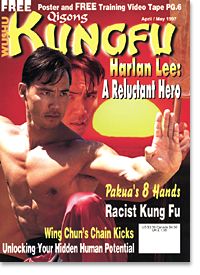
Cover Story:
Reluctant Hero
Harlan Lee knows that learning how to live is more important than learning how to fight
Features:
Lan Shou Quan: Hidden in Plain Sight
In the heart of teeming Shanghai, an obscure fighting system called Lan Shou Quan has survived over three centuries, as little-known in China as the rest of the world. Despite being cloaked in obscurity, Lan Shou Quan has a dramatic history, a respected lineage and an intriguing combat strategy. Lan Shou's story should be well-known, but its practitioners prefer to remain hidden in plain sight
Shaolin Monks Go Hollywood
When Nixon opened up China to the West in the early seventies, little did he envision Shaolin Temple kung fu monks in Hollywood. They probably didn't either, for that matter. But the Hollywood Palladium was indeed the perfect venue for nearly two hours of flashing weapons and spine tingling qi gong feats which wowed a Los Angeles crowd made up of Chinese families, rock n' rollers, martial artists and curious onlookers
Join the Chain Gang
Wing Chun's hand techniques combined with its lethal chain kicks will confuse and deceive your opponents. Wing Chun is well known for its devastating hand techniques, but most people assume that the style strictly focuses on hand combat and is limited in its use of kicks. This is not true. In fact, Wing Chun kicks should be used simultaneously with the execution of a hand technique. When you are striking with a punch high to the face, and low with a kick to the opponent's knee, this makes your attack very difficult to block and overcome
Practicing Pakua Palm
Pakua Palm, also called Pakua Chang or Pakua Combination Palm, is a hand technique that mainly involves palm change-ups and circular steps. It incorporates both fighting skills and chi manipulation with circular walking movements
Cut to the Quick
Saber training tips from The National Wushu Training Center. One aspect of wushu training is more important than any other: Without exception, every successful wushu athlete has solid basics, and everyone who neglects the consistent, long term basics training fails to achieve greatness
A Love for Wushu
Wushu is often credited with graceful forms, astounding athletic feats, and street-worthy fighting skills, but few would have guessed its aerial acrobatics could make a heart leap as well. Yet such is the tale of Phillip Wong and Zhang Hong Mei, two people brought together in a match made in wushu
Eliminate the False, Retain the Truth
Master Li Luoneng learned Ten Grand Forms of Hsing I Quan [also spelled Xingyiquan] from Dai Longbang, Shan Xi. The forms were the dragon, tiger, monkey, horse, chicken, swallow, sparrow, snake, eagle and bear. To these, the tuo (shieldbug) and tai (falcon) were added, making the present Hsing I Twelve Gland Forms
Is Kung Fu Racist?
The challenges and triumphs for African-Americans in the Chinese style martial arts
The Buddha on Your Nose
Selected moments of quietude directed by your martial arts instructor is often the only significant introduction to meditation you will ever get-unless you search it out for yourself. The basics of meditation for the beginner stem from a few principles that provide a foundation for the serious martial artist to develop single mindedness and unity of action. We all are told to focus when we train, but without meditation, focus is impossible. It is the meditative element of unconscious inaction that directs the force of our chi power
Qigong:
Discover Your Hidden Human Potential
Qigong is the one thing which links traditional Chinese medicine (qigong being the only component of TCM which teaches self-healing) with the Chinese martial arts. All traditional Chinese martial arts contained internal training (qigong). It prevents and cures many kinds of disease, in addition to being a highly enjoyable method of self-maintenance. In theory, at least, a health system such as this should have no side effects, but unfortunately, incorrect methods of practice can produce unpleasant side effects
Chi Kung's Brain-Body Connection
"The mind is the commander; the body is the army. Where the mind goes, the chi flows."-Taoist saying Many Chinese styles use mental imagery in their chi kung training, often without understanding why; frequently they don't know of the many alternative methods that can have specific applications. Two very popular methods used are the micro-cosmic orbit and Buddhist breathing
Amazing Stories
Science-Defying Experiments in the World of Chi Kung
Ask the Experts
What is the exact difference between Bagua Zhang and Baji Chuan (Quan). I know that Ba is the Pinyin (Mandarin) for the number eight, but what is the difference in the theories of combat and the basis of the styles? Lawrence Bennett, Honolulu, Hawaii. Adam Hsu, one of the world's foremost experts in Baji Quan and Bagua Zhang, has the answer
Tiger's Tale
Tiger's TaleTalk
Click here for Feature Articles from this issue and others published in
1997 .
Written by for KUNGFUMAGAZINE.COM
![]() Print Friendly Version of This Article
Print Friendly Version of This Article















